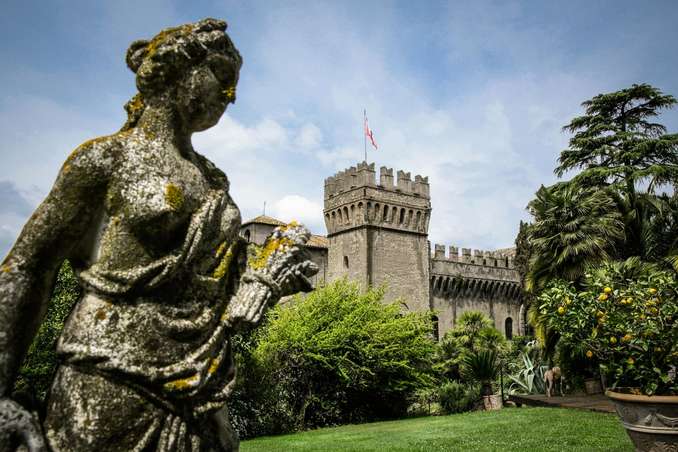
4 August 2017
Castello di Torcrescenza
Immersed in a century-old park on the outskirts of Rome, Torcrescenza Castle dates back to the second half of the 15th Century when there was an ancient tower here built in the year 1100. The natural driveway leading to the castle is surrounded by woods filled with oak, pine ad laurel trees where pheasants and porcupines gather as dusk falls, and that continues with borders of melandine roses, in flower from May until November.
The Castle has inspired artists such as Claude Lorrain who portrayed it in a 1648 painting exhibited at New York's Metropolitan Museum, and Nicolas Poussin who included it in a number of his landscapes.
It is also known as the castle of the mimosas because it becomes tinged with gold in February.
This is a composite garden in which the precision of a formal design is exalted by fountains channeling water falling from one level to another, marks the outdoor stairway creating playful effects, emphasizig the imagination of Mediterranean gardens. Here there was created an area for plants sent from the Biviere Gardens in Sicily, and, never forgetting the land of her childhood, she has chosen to add fragrance to her succulent plants with a collection of small ancient potted citrus plants which are placed in a greenhouse during the winter. This idea came from a picture painted by Joseph Heinz in 1625, showing the Italian Gardens in the Villa Borghese where there are small citrus tree in order to allow the ladies to pick the fruit more easily. Imitating Villa Borghese's secret garden, one can come across irises, anemones also known as ''flowers of the wind'', myosotis and collections of historical narcissuses and tulips.
There are also many aromatic and ornamental plants and roses in the garden. One enters the castle from the drawbridge coming to the cloister with its fifteen octagonal peperino columns covered in ficus pumila. This is a garden with special romantic charm that enchants all visitors.
The Castle has inspired artists such as Claude Lorrain who portrayed it in a 1648 painting exhibited at New York's Metropolitan Museum, and Nicolas Poussin who included it in a number of his landscapes.
It is also known as the castle of the mimosas because it becomes tinged with gold in February.
This is a composite garden in which the precision of a formal design is exalted by fountains channeling water falling from one level to another, marks the outdoor stairway creating playful effects, emphasizig the imagination of Mediterranean gardens. Here there was created an area for plants sent from the Biviere Gardens in Sicily, and, never forgetting the land of her childhood, she has chosen to add fragrance to her succulent plants with a collection of small ancient potted citrus plants which are placed in a greenhouse during the winter. This idea came from a picture painted by Joseph Heinz in 1625, showing the Italian Gardens in the Villa Borghese where there are small citrus tree in order to allow the ladies to pick the fruit more easily. Imitating Villa Borghese's secret garden, one can come across irises, anemones also known as ''flowers of the wind'', myosotis and collections of historical narcissuses and tulips.
There are also many aromatic and ornamental plants and roses in the garden. One enters the castle from the drawbridge coming to the cloister with its fifteen octagonal peperino columns covered in ficus pumila. This is a garden with special romantic charm that enchants all visitors.
The love of gardening is a seed once sown that never dies- Gertrude Jekyll - |






